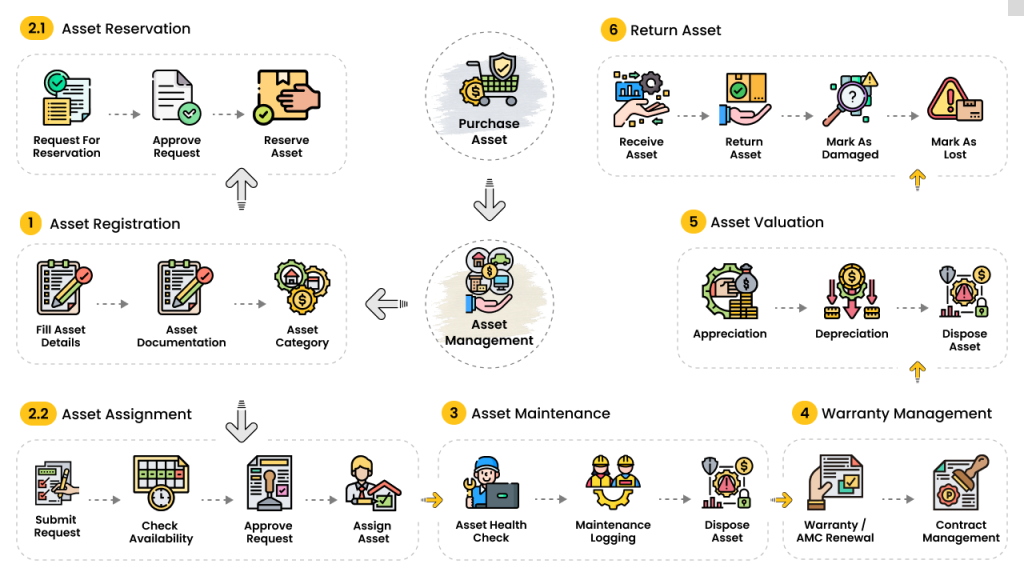System Workflows
Purpose
This serves as an indispensable resource within the broader context of the Complete Solution Guide: ROCKEYE – Asset Management. Its primary purpose is to deliver a comprehensive understanding of the system by providing detailed insights into system overviews, and workflows.
System Architecture Visualization: Illustrate the system’s architectural elements, showcasing modules, components, and subsystems also Enhancing comprehension of the overall system structure through visual representation.
System Overview: Offer a high-level overview of the ROCKEYE – Asset MAnagement and provide context on the system’s purpose, functionalities, and role within the broader organizational framework.
Workflow Details: Detail key operational workflows within the ROCKEYE – Asset Management, and provide step-by-step visual representations of processes, from user interactions to backend operations.
System Overview
In this section, we present a visual representation of the system overview of the product. The diagrams below offer a comprehensive view of how various modules interact to deliver a seamless and efficient user experience. The below figure depicts the system overview of the ROCKEYE – Asset Management, offering quick insight into its structure and key elements
The below Figure 1 depicts the system overview of the ROCKEYE – Asset Management, offering a quick insight into its structure and key elements
ROCKEYE Asset Management Module based on the diagram you provided. It covers all processes from asset registration to return, including reservation, assignment, maintenance, valuation, and warranty managemen
Asset Registration
This is the first step where an asset is officially recorded into the system.
Steps:
- Fill Asset Details: Enter key details such as asset name, serial number, model, purchase date, cost, and vendor.
- Asset Documentation: Upload and manage associated documents like invoice, warranty papers, user manuals, etc.
- Asset Category: Classify the asset into a category (IT, Furniture, Machinery, etc.) to streamline reporting, valuation, and tracking.
System Actions:
- Create a unique Asset ID.
- Store asset metadata and documents.
- Link asset to asset category master.
2.1 Asset Reservation
This process allows employees or departments to reserve assets for future use.
Steps:
- Request for Reservation: Submit a reservation request specifying purpose, duration, and required asset.
- Approve Request: Department manager or asset admin approves/rejects the reservation.
- Reserve Asset: Once approved, the asset is reserved in the system, and no other user can assign it during the reserved time.
System Actions:
- Track reservation status.
- Block asset availability for other processes during reserved period.
- Generate reservation alerts.
2.2 Asset Assignmen
Assign assets to users post-reservation or direct request.
Steps:
- Submit Request: User requests an asset.
- Check Availability: System validates asset stock and reservation conflicts.
- Approve Request: Approval workflow is triggered.
- Assign Asset: Asset is allocated to the requester with assignment logs.
System Actions:
- Update asset status to “Assigned.”
- Notify the user.
- Start tracking asset usage history.
3. Asset Maintenance
Ensure asset longevity and performance through routine and ad-hoc maintenance.
Steps:
- Asset Health Check: Schedule and conduct routine inspections.
- Maintenance Logging: Log issues, service history, maintenance cost, vendor, and parts replaced.
- Dispose Asset: If the asset is beyond repair, it moves to the disposal process.
System Actions:
- Generate maintenance schedules.
- Notify maintenance team.
- Update asset condition and next due date.
4. Warranty Management
Track warranties and manage annual maintenance contracts (AMC).
Steps:
- Warranty / AMC Renewal: Record warranty periods, get alerts for expiry, and handle AMC renewals.
- Contract Management: Upload and maintain vendor contracts related to asset maintenance and warranties.
System Actions:
- Trigger notifications for upcoming renewals.
- Link contracts to asset records.
- Generate reports on warranty status.
5. Asset Valuation
Monitors asset value over time for accounting and audit purposes.
Steps:
- Appreciation: Update asset value if its market price increases.
- Depreciation: Automatically calculate depreciation using defined methods (Straight Line, WDV, etc.).
- Dispose Asset: Retire the asset if fully depreciated or no longer in use.
System Actions:
- Auto-run depreciation cycles.
- Maintain valuation history.
- Trigger disposal workflows.
6. Return Asset
Covers the return and status change of an asset post-usage.
Steps:
- Receive Asset: Accept the returned asset and log return condition.
- Return Asset: Asset is checked and processed back to inventory.
- Mark as Damaged: If damaged, update status and initiate repair/disposal.
- Mark as Lost: If not returned or misplaced, mark as lost for audit.
System Actions:
- Update asset availability.
- Trigger damage/loss reports and audit trail.
- Notify relevant teams (IT, Admin, Audit).
